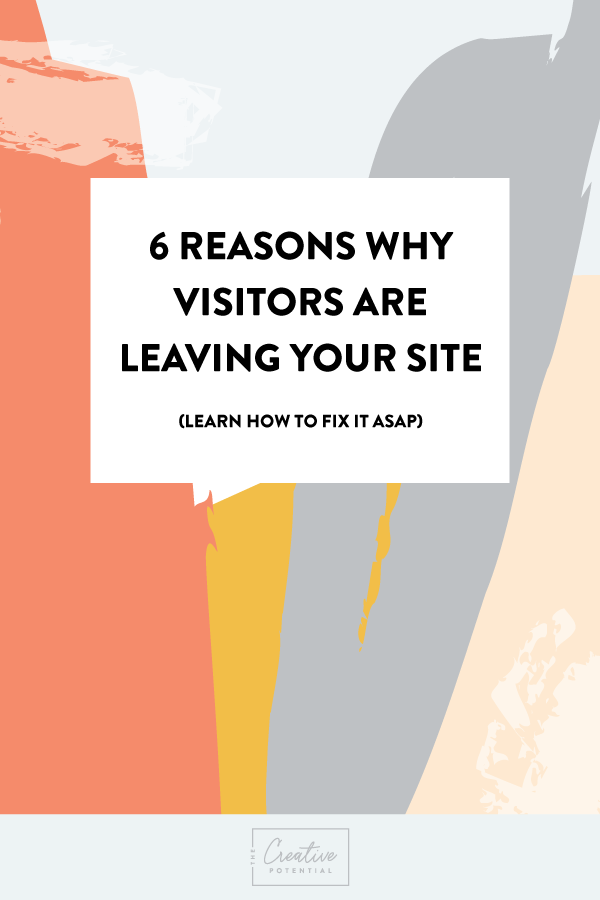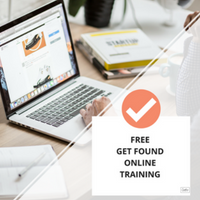
Have you ever gone to a party or event, took a quick look, and decided to just leave? Did you ever think later what if I missed out on something? Or what I was just being too judgmental? Chances are probably not. You made your decision and went with it.
Your “bounce rate” is the same thing when it comes to your website. It’s the percentage of visitors who come to your website (home page, blog post, sales page, landing page, etc.) and leave without engaging with any content, filling out your opt-in form, or clicking through to another page. It’s people who just saw the page they landed on and said “nope… that’s not for me.” Or they got caught up and distracted by something else. The key is to get your bounce rate low- under 40% is ideal. You’ll see more about bounce rates on next week’s blog post. You want your bounce rate to be as low as possible. You want to keep people around, get them to engage, and take the next step(s) on your website or sales page.
Here are some reasons why potential clients or buyers are leaving your site and how you can fix it:
1. I love slow websites- said no one ever!
I imagine you don’t want to slow down your site but these are just some of the reasons why it might be happening:
- You added a few too many oversized images that can’t be downloaded quickly.
- Used too many images caused too many requests on each page load.
- Implemented custom fonts that no one has that must be downloaded before anyone can even read the page.
- Added a lot of slider images that take too long to load especially on mobile
All of these factors can lead to slow page loads. According to Neil Patel, surveys done by Akamai and Gomez.com, nearly half of web users expect a site to load in 2 seconds or less, and they tend to abandon a site that isn’t loaded within 3 seconds. 79% of web shoppers who have trouble with website performance say they won’t return to the site to buy again and around 44% of them would tell a friend if they had a poor experience shopping online.
How do you know if you’ve gone above 2 seconds? I love using Pingdom that will help with the page load. To see how your site is measuring up go to tools.pingdom.com. You can just plug in your domain and test your site for free.
2.Using lots of attention-grabbing images that steal the show from your call to action.
This falls under the concept of a poorly designed page, but I see it often enough that I need to call it out. People spend so much time curating stock art, background images, rotating sliders, thumbnails, and other images that steal attention. Better yet you forget what the page is all about and why you landed there. Pages should be combined with both visuals and copy.
3. Making your web pages or landing pages hard to read.
I know if I can’t read a site with my glasses on chances are I am going to leave that site! Any distracting elements can reduce the credibility of your site, which causes visitors to search for the nearest exit. Most common problems involve issues of legibility. For example, red cursive text on a black background will not read well. It might look great artistically but it doesn’t translate to the view. There are certain kinds of fonts that are also difficult to read. People scan content quickly online, so they will not want to work just to read lines of text.
4. Sending the wrong traffic to your site.
This is right up there with giving visitors something they did not expect. I don’t know about you but I get pretty aggravated when I am searching for something (I’ll use black skirts as an example) and I click on an image and it directs me to a red skirt. If your landing page sells a product that’s targeted at hair products for curly hair, but it directs to a page with images hair products for straight hair you may have missed out on potential buyers and sales.
You can drive a ton of traffic to a landing page or web page with a Facebook ad or social media post… the real question is whether or not you can drive the RIGHT kind of traffic to your page.
5. If spelling and grammar is just not your thing, find someone or a proofreading tool that will help you.
Ok, I won several spelling bees in elementary school but that certainly does make me an expert speller by any sense of the imagination. I rely on a proofreading tool like Grammarly to help me clean up my posts and pages. Global Lingo surveyed 1,029 people and found that 59% “would not use a company that had obvious grammatical or spelling mistakes on its website or marketing material”. 74% answered yes when asked, “whether or not they tended to notice the quality of spelling or grammar on a company’s website.” Don’t let simple spelling errors increase your bounce rate.
6. Asking for too much information.
Have you ever come across a site when they ask too many questions on a form? Why are they asking me my eye color? Unless it is for a survey I usually leave the site. Your web pages are no different. As a general rule, you should not be asking for information that you are NOT going to actually use to help the potential customer on the next step of their journey.
You don’t need five different ways to contact everyone, but if you are selling perfume for example… you may want to know their favorite scent or brand of perfume… as long as you are going to start using it to provide them with more personalized offers or marketing campaigns.
Want to learn more? Make sure you sign up for our FREE training: Get Found Online that starts on July 19th. It’s a 2 part video training and a live masterclass that will be sure to leave you with tons of actionable steps to get your business found online no matter if you sell products or services!

You can sign up for FREE right here: bit.ly/findmywebsitenow










comments go here
Post comments here